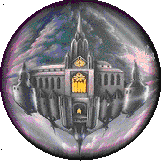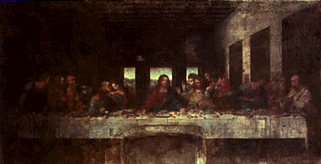| |
23th Psalms in Scottish

Wha is my shepherd, weel I ken,
The Lord Himsel' is he.
He leads me whaur the girse is green,
An' burnies quate be.
Aft times I fain astray wad gang,
An' wann'r far awa'
He fins me oot, He pits me richt
An' brings me hame an' a'.
Tho' I pass through the gruesome clough
Fin' I ken He is near.
His muckle crook will me defen',
Sae I ha'e nocht tae fear.
Ilk comfort whilk a sheep could need
His thochtfu" care provides,
Tho' wolves and dogs may prowl aboot,
In safety me He hides.
His guidness and His mercy baith
Nae doot will bide wi' me;
While faulded on the fields o' time,
Or o' eternity.
May Alba gu Brath


The Last Supper

The story behind the painting of The Last Supper is extremely interesting and
instructive. Two incidents connected with this painting afford a most convincing
lesson on the effect of thought in the life of a boy or girl or of a man or
woman. The Last Supper was painted by Leonardo De Vinci, a noted Italian artist.
The time engaged for its completion was seven years. The
figures representing the twelve apostles and Christ Himself were painted from
living persons. The live model for the painting of the figure of Jesus was
chosen first. When it was decided that De Vinci would paint this great
picture, hundreds and hundreds of young men were carefully viewed in an
endeavor to find a face and personality unaffected by sin. Finally, after weeks
of laborious searching a young man, nineteen years of age, was selected as the
model for the portrayal of Christ. For six months De Vinci worked on the
production of this leading character of the famous painting.
During the next six years De Vinci continued his labors on his sublime
work of art. One by one fitting persons were chosen to represent each of the
eleven apostles, space being left for the painting of Judas Iscariot as
the final task of this masterpiece. This was the apostle, you remember, who
betrayed his Lord for thirty pieces of silver, worth $16.95 in our
present day currency. For weeks De Vinci searched for a man with a hard callous
face, with a countenance marked by scars of avarice, deceit, who would betray
his best friend. After many discouraging experiences in searching for the
type of person required to represent Judas, word came to De Vinci that a man
whose
appearance fully met the requirements had been found. He was in a dungeon in
Rome, sentenced to die for a life of crime and murder. De Vinci made the
trip to Rome at once, and this man was brought out from his imprisonment in
the dungeon and led into the light of the sun. There De Vinci saw before him
a dark, swarthy man, his long shaggy and unkempt hair sprawled over his
face. A face which portrayed a character of viciousness and complete ruin. At
last the painter had found the person he wanted to represent the character of
Judas in his painting. By special permission from the king, this prisoner was
carried to Milan where the fresco was being painted.
For six months the prisoner sat before De Vinci, at appointed hours each day, as
the gifted artist diligently continued his task of transmitting to
his painting this base character in the picture representing the traitor and
betrayer of the Savior. As he finished his last stroke, he turned to the guards
and said, "I have finished, you may take the prisoner away."
Suddenly the man broke loose from their control and rushed up to De Vinci,
crying as he did so; "Oh, De Vinci, look at me! Do you not know who I
am?"
De Vinci, with the trained eye of a great character student, carefully
scrutinized the man upon whose face he had constantly gazed for six months
and replied; "No, I have never seen you in my life until you were brought
before me out of the dungeon in Rome." Then lifting his eyes toward heaven,
the prisoner said, "O God, have I
fallen so low?" Then turning his face to the painter he cried,
"Leonardo De
Vinci, look at me again, for I am the same man you painted just seven years ago
as the figure of Christ!"
This is the true story of the painting of The Last Supper that teaches so
strongly the lesson of the effects of right and wrong thinking of an
individual. He was a young man whose Character was so pure and unspoiled
by the sins of the world, that he represented a countenance and innocence and
beauty fit to be used for the painting of the representation of Christ. But
during the next seven years, following a life of sin and crime, he was changed
into a perfect picture of the most notorious character ever known in the history
of the world.



Click on candle to go to more poems
|